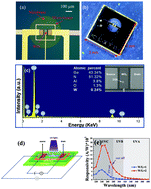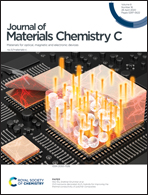A high responsivity and controllable recovery ultraviolet detector based on a WO3 gate AlGaN/GaN heterostructure with an integrated micro-heater†
Abstract
A high responsivity and controllable recovery ultraviolet (UV) photodetector based on a tungsten oxide (WO3) gate AlGaN/GaN heterostructure with an integrated micro-heater is reported for the first time. The WO3 nanolayer was deposited by physical vapor deposition (PVD) for deep UV absorption and the micro-heater was integrated for chip level heating and cooling. Our device when exposed to UV wavelength exhibits a high responsivity of 1.67 × 104 A W−1 at 240 nm and a sharp cut-off wavelength of 275 nm. More importantly, the persistent photoconductivity (PPC) effect can be eliminated by a novel method, mono-pulse heating reset (MHR), which consists in applying an appropriate pulse voltage to the micro-heater right after the removal of the UV illumination. The recovery time was reduced from hours to just seconds without reducing the high responsivity and stability of the photodetector. The UV detection, high responsivity, high stability, controllable recovery process and low production cost of GaN-based photodetectors make these devices extremely attractive for several applications, such as fire detection and missile and rocket warning.



 Please wait while we load your content...
Please wait while we load your content...